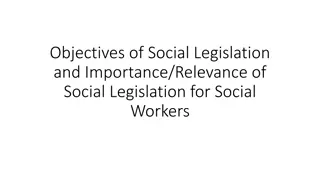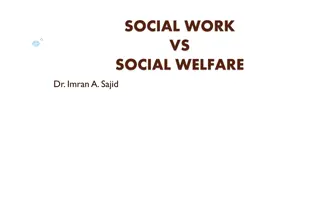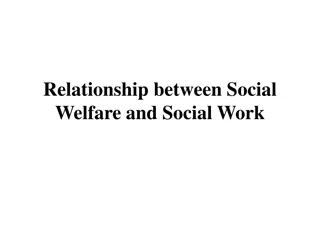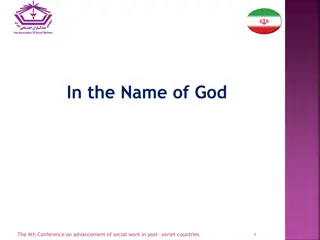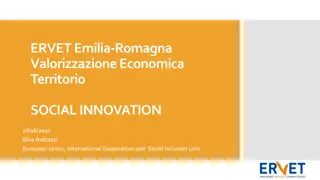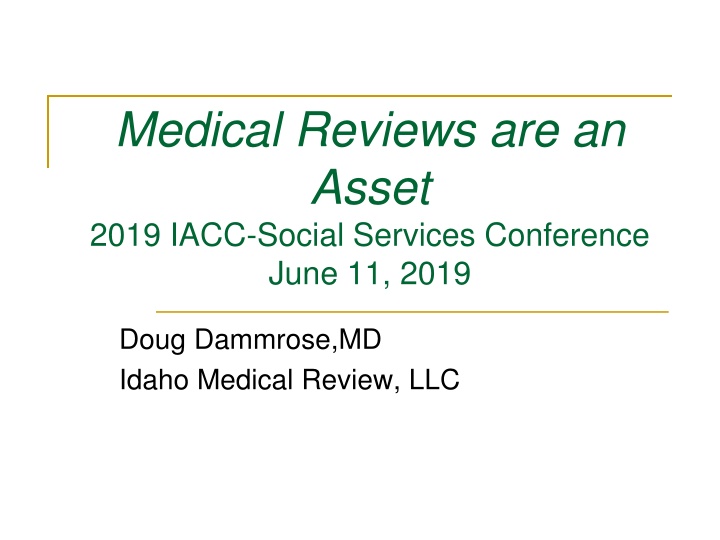
Insights on Medical Reviews and Healthcare Costs
Discover the significance of medical reviews in managing healthcare costs and improving quality of care. Explore the history, impact, and applications of medical review programs, along with insights on hospital charges, Medicaid reimbursement, and challenges like overutilization in healthcare services.
Download Presentation

Please find below an Image/Link to download the presentation.
The content on the website is provided AS IS for your information and personal use only. It may not be sold, licensed, or shared on other websites without obtaining consent from the author. If you encounter any issues during the download, it is possible that the publisher has removed the file from their server.
You are allowed to download the files provided on this website for personal or commercial use, subject to the condition that they are used lawfully. All files are the property of their respective owners.
The content on the website is provided AS IS for your information and personal use only. It may not be sold, licensed, or shared on other websites without obtaining consent from the author.
E N D
Presentation Transcript
Medical Reviews are an Asset 2019 IACC-Social Services Conference June 11, 2019 Doug Dammrose,MD Idaho Medical Review, LLC
Introduction and Outline Why Do Medical Review?......Cost Health Care Spending History of Medical Review with the program Impact/ROI Application of the statutory language Appeals
Health Care: The Big Picture In most of the last 50 years health care costs increased greater than the economy as a whole Health care costs are 18% of US GDP 30% increase in personal income in last decade was eaten up by 76% increase in health care cost $750 B in waste through overutilization or ineffective care Institute of Medicine: Best Care at Lower Cost
Hospital Charges Related to Costs/CPI 4 16 14 Charges 2.4X Cost Charges 3.7X CPI 12 10 8 6 4 2 0 1984 2013 CPI Hospital Costs Hospital Charges
Medicaid Reimbursement Based on the Medicare Cost Report Looks at the true cost to a facility for the services they provide. Adjusts for uncompensated care, student training costs, local wage index etc. Then looks at the charges. The cost/charge ratio is the number reflected in the interim rate
Medicaid Reimbursement Examples of hospital cost/charge If the Rate is 17%, that means that the cost/charge ratio is 17% If there is a $1000 charge, the actual hospital cost is $170, or markup of 588% Margin of 83% The hospital rates range for 17% to 55% for major hospitals.
Medically necessary but excessive charges due to creative coding Recent review for a commercial payer Duplicated coding Charges submitted $343,000 Charges allowed after audit for correct coding $83,600 Interim rate 50% applied to calculate payment $171,500 versus $41,800
Overutilization is a Problem Study of physicians felt 30% of all medical care is not necessary Risk of overutilization increases if the provider has compensation linked to doing more. Hippocratic oath: First do no harm. Overutilization leads to harm through unintended consequences
Brief History Ada has used a reviewer since 1999 Prior to 2009 medical review was a letter signed by any licensed physician that care was necessary 2009 move for Medicaid to administer CAT S1158 was written to manage the population like commercial health insurance Intent was to have the complete spectrum of Utilization, Case, and Population health management
History continued Unfortunately, No resources for management were funded The population could not be identified easily and most cost management was after the service The decision was made that cost would be managed applying the statutory language to payment
History: Key Takeaway Points The indigent program essentially became a payer of services like a commercial insurance company The language has not been perfected, like commercial insurance contract language, and there are internal conflicts with determination and payment options The statute determines if there should be payment for a medical service, it does not say a service cannot be provided.
Idaho Medical Review, LLC Who are we? 2 Board Certified physicians with over 80 years of collective clinical and health plan experience 3 RNs with over 50 years of collective health plan experience Nearly 2000 narrative style medical reviews/yr About 1200 abbreviated reviews/yr Application of evidence based medicine Experience with commercial insurance review criteria, review criteria, and coding certification
Utilization Management 31-3502(28) The evaluation of medical necessity, appropriateness, and efficiency of the use of health care services, procedures and facilities and may include, but is not limited to, preadmission certification, the application of practice guidelines, continued stay review, discharge planning, case management, preauthorization of ambulatory procedures, retrospective review and claims review .Utilization management may also include the amount to be paid based on the application of the reimbursement rate to those medical services determined to be necessary medical services.
Necessary Medical Services 31-3502(18) (a) Health care providers, exercising prudent clinical judgment, would provide to a person for the purpose of preventing, evaluating, diagnosing or treating an illness, injury, disease or its symptoms; (and) (b) Are in accordance with generally accepted standards of medical practice; (and) (c) Are clinically appropriate, in terms of type, frequency, extent, site and duration and are considered effective for the covered person's illness, injury or disease; (and) (d) Are not provided primarily for the convenience of the person, physician or other health care provider; and (e) Are the most cost-effective service or sequence of services or supplies, and at least as likely to produce equivalent therapeutic or diagnostic results for the person's illness, injury or disease. This language is related to determination of payment for medically necessary services . Determination is best made after a physician review of the clinical record.
Emergency 31-3502(18) 12) "Emergency service" means a service provided for a medical condition in which sudden, serious and unexpected symptoms of illness or injury are sufficiently severe to necessitate or call for immediate medical care, including, but not limited to, severe pain, that the absence of immediate medical attention could reasonably be expected by a prudent person who possesses an average knowledge of health and medicine, to result in: (a) Placing the patient's health in serious jeopardy; (b) Serious impairment to bodily functions; or (c) Serious dysfunction of any bodily organ or part.
Medically Necessary but not covered B. Necessary medical services shall not include the following: (a) Bone marrow transplants; (b) Organ transplants; (c) Elective, cosmetic and/or experimental procedures; (d) Services related to, or provided by, residential, skilled nursing, assisted living and/or shelter care facilities; (e) Normal, uncomplicated pregnancies, excluding caesarean section, and childbirth well-baby care; (f) Medicare copayments and deductibles; (g) Services provided by, or available to, an applicant from state, federal and local health programs; (h) Medicaid copayments and deductibles; and (i) Drugs, devices or procedures primarily utilized for weight reduction and complications directly related to such drugs, devices or procedures.
Managing the Medically Indigent and Catastrophic Health Care Cost Programs Apply the definitions in the statute as it relates to payment for medical services to: Strictly enforce the coverage defined in statute Eliminate Waste and Reduce Cost Ineffective treatment Excessive treatment Harmful treatment
Impact First 18 months of the program saved $11 million Since 2010 the medical review process has saved the counties and CAT about $63 million With subsidized coverage and improvement of provider compliance the savings continue to be about $4.3 million/yr.
Questions to this point? Raise your hands, how many read a medical review? How many have looked at a hospital bill? Who feels uncomfortable about the medical review and decisions about medical necessity?
Requesting Review Request all records from the facility for the dates of the application. Sort the records by date so that they are sequential. Separate out and scan to SCI only the following records:
Standardized Record Requests History and Physical Examination Operative Reports Dictated Radiology Reports Discharge Summary UB-04 Detailed Bill Any additional records might be requested from the county based on the specific case prior to completion of the review
Requesting Review (continued) In your email state any specific questions you have identified and desire for specific medical answers. Rush orders should be rare and the time frame you need to meet should be included and why. We work these cases every night and some weekends, therefore typically turn them around in 24-48 hours.
Medical Record Reviews: Best Submissions Practices Copy Melissa and Kathryn on all review requests Correct numbers into SCI IN the subject line Sequential records added complicates the review process(get all at once) PLEASE TRY TO AVOID MAIL Use SCI and limit to aforementioned records. Request starts at county but ends at CAT
Reading and interpreting Have all other sources of payment been considered? For this episode of care which services provided or requested are medically necessary and emergent as defined in the statute? What is the recommended reimbursement for the services defined as medically necessary and emergent? Comparative Data (For Information Only) 1. 2. 3. 4.
Reading and interpreting (continued) Other resources for payment. We may feel the patient appears to meet the Social Security criteria for disability. Because this could allow Medicaid coverage and avoid a future issue, the patient should be referred for disability determination. We may identify an insurer or a resource like the VA that would be reference in this section.
Reading and interpreting (continued) Analysis of the bill may identify charges that are excessive (implants, pharmacy, etc). A portion of the entire stay may not be approved, and the unadjusted Medicaid rate should be applied to the only dates allowed. It is possible that continued stay but at a lower level of care should be reimbursed at a swing bed/SNF rate.(statute does not allow for SNF facility payment-don t confuse the two) Comparative data is given to facilitate understanding of the charges compared to national norms and used by the CAT fund.
Managing an appeal from the provider Only provide the medical review if the appeal is related to medical necessity, not if the denial is another reason, such as, timely filing. IF the provider asks for a peer-to-peer after a denial of payment, and they are planning an appeal, I will do the peer to peer in the hope we can avoid an appeal hearing. Involve me early in the appeal and provide me specifics. Arrange time with the prosecutor to develop the best defense.
Example of successful peer to peer We had denied outpatient department long- term antibiotics since it was not the lowest cost setting. OPD charges=$22,000 The facility appealed and had a letter from the discharging physician I contacted the local infusion company and the facility s home health department and found they could deliver the same treatment for about $100/day or $3,000.
Questions raised by Commissioners Non-compliant applicant Emergent vs. Non-Emergent care vs Continuation of an Emergency Lower Level of Care Why do I include a bullet related to Medicare reimbursement?
Non-Compliant Applicant Are not provided primarily for the convenience of the person, physician or other health care provider Use of ER rather than outpatient follow up The provider (hospital or doctor) has not acted to change the behavior Should they continue to be rewarded with payment?
Emergent vs. Non-Emergent care vs Continuation of an Emergency Non-emergent typically means none of the qualifiers of Emergency are present The care does not need to be done immediately Typically outpatient Notification via the 10-day application Question complicated by Fifth District determination.
Continuation of the Emergency If the application was part of a 31 day application, i.e. started in the ER Example-Fracture care, splinted in ER but needs definitive orthopedic procedure Usually completed within 10 days.
Lower level of care Discharge planning should begin on admission Determining what funding is available for continued care should be part of hospital case management. Statute language limits management somewhat
Reference to Medicare payment Single best comparator of the cost of care Educational and informational for decision makers to understand the charges relative to some gold standard








